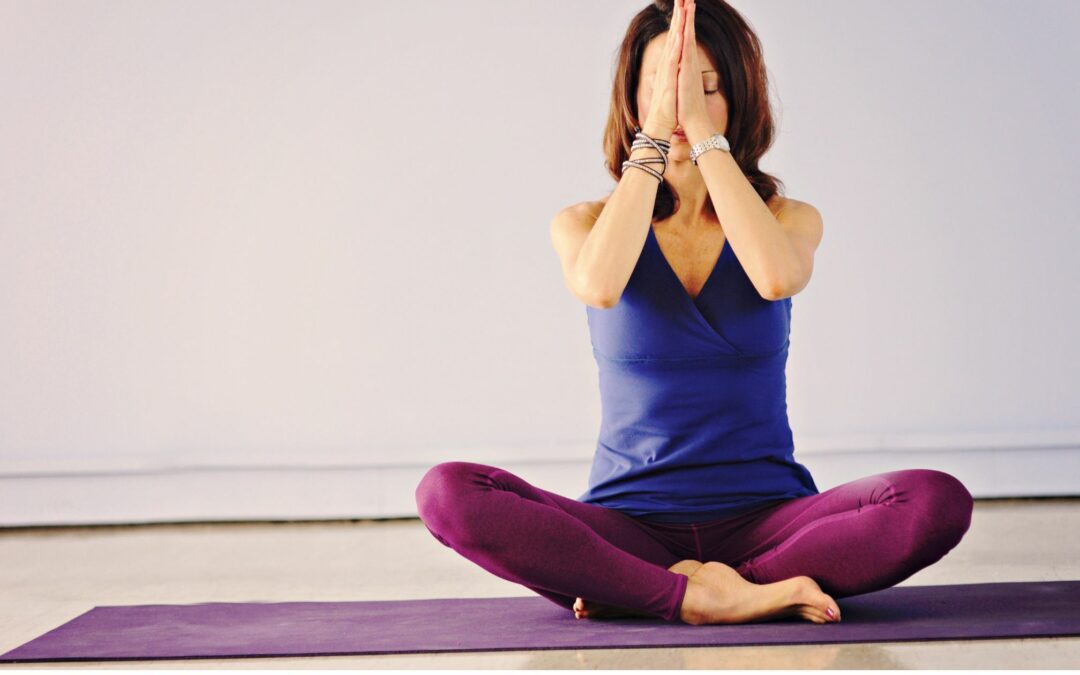
Yoga Helps With Menopause Symptoms
It’s supposed to be our time for aging gracefully. But how can we feel graceful when midlife brings symptoms like insomnia, weight gain, irritability, and joint pain? Read on to learn how yoga helps with menopause symptoms – the 10 most common.
Yoga Strengthens Bones

At every moment, cells in our bones are naturally deteriorating and regenerating. After menopause, the regrowth stage slows, so our bones start to lose density. This can lead to fractures, pain, loss of height, and even dowager’s hump (kyphosis).
How can yoga improve bone strength in perimenopause?
According to a 2016 study, six months of regular yoga was enough to improve bone density in women already suffering from osteoporosis.
How? Pressure stimulates bones to retain more of the calcium we get from food and supplements and slows the break-down part of the cycle, meaning we stop losing faster than we can rebuild.
We get this pressure from weight-bearing activities like running and walking. And yoga is even better, because it strengthens arm, spine and shoulder bones as well as legs.
Planks, side planks and crow poses all decrease your risk of fracturing arm or shoulder bones, while Warrior and Chair poses strengthen leg and foot bones.
Yoga Reduces Joint Pain
When estrogen levels drop after menopause, we can experience painful swelling in our joints, that sometimes turns into arthritis.
How does yoga help with joint pain?
When your joints hurt, you don’t feel like moving. But the less you move, the more joint pain increases.
Yoga is a great solution because movements are safe and gentle but still provide enough activity to make our joints feel better, and keep them operating in their full range.
Attend a full class a few times a week and do some gentle warm-ups like arm circles and leg lifts in between times to keep joints lubricated and moving in their full range.

Yoga Improves Sleep
Hands up…who’s having trouble sleeping?
40% of us struggle with terrible sleep in peri- and post-menopause. (Compared to only 12% before menopause). Blame the drop in estrogen and progesterone for insomnia, night sweats, restless legs, snoring and sleep apnea, and increased depression and anxiety.
How does yoga help with sleep?
A 2022 study found that yoga significantly improved sleep quality for post and perimenopausal women.
A regular yoga practice can make it easier to stick to healthy sleep routines.
Mindfulness practices increase melatonin which helps with going to sleep and sleeping more deeply.
And even the annoying symptoms of restless leg syndrome are shown to reduce in women who practiced yoga regularly for eight weeks.
And while yoga doesn’t stop night sweats, it can lessen the anxiety we feel about it. So when the hot flash is over, we get back to sleep more quickly.
Practice regulated breathing (pranayama) in bed, rather than let your mind run away into worries about tomorrow. Intentionally focus on a slower exhale to shift your body out of the sympathetic (fight or flight) function and into a parasympathetic (rest and digest) phase.
Yoga Helps Us Cope with Irritability
Irritability, sadness and mood swings are extremely common for women post-menopause. The drop in estrogen and progesterone can feel like constant PMS.
How does yoga help with irritability?
Focusing on sensations while we practice yoga actually enhances our ability to ride out waves of emotion in daily life. We get better at observing a situation and our emotional reaction without judgment.
For example, instead of shrieking at your family’s slobbiness, you might simply observe, “Seeing my family’s shoes and socks scattered around the entryway makes my heart beat really fast. My mind is filled with swear words. I feel like yelling. I’m experiencing rage about shoes.”
Then you get to choose between telling your family off now, or talking to them calmly after taking a brisk walk.
Yoga Supports Heart Health
After age 50, women’s risk of heart disease increases significantly. The good news is that women who get their hearts pumping by moving their bodies regularly have a lower chance of suffering from heart disease.
How does yoga help with heart health?
Yoga is a great option for those of us who don’t like the more obvious cardio exercises like running or team sports. Take a vinyasa class once a week. Or add a handful of sun salutations to your daily hatha practice.
Yoga improves heart health indirectly too. People who do yoga regularly are more likely to feel like engaging in other forms of exercise. A regular yoga class can also motivate you to eat healthier, quit smoking or cut down on alcohol intake.
Yoga Improves Balance
Of course, you know yoga helps with balance. Tree pose or Vrksasana is probably the most common image you’ll see if you search for yoga images online. But how does that relate to peri- and post-menopause?
Why Balance is Important after Menopause
Better balance prevents falls. And since falls can result in fractures for older women, balance is super important. So don’t skip Eagle and Tree just because they frustrate you. These poses help you keep your footing when pathways get icy or the dog rushes past you on the stairs.

Yoga Increases Esteem
Perimenopause and menopause can really kick you right in the esteem. Not only are you dealing with moodiness, exhaustion, weight gain, and hot flashes, but you may also feel embarrassed about these perfectly normal symptoms.
How does yoga improve self-esteem after menopause?
A regular yoga practice maintains your confidence in your physical abilities: “So what if you’ve gained a few pounds! You can hold a Warrior 3 longer than any of them!”
Meditation brings your perspective back to your own inner experience. Remember that how you perceive the world is more important than how the world perceives you.
Yoga Reduces Chronic Pain
Chronic pain is an unfortunate reality for many women in later life. Migraines, fibromyalgia, back pain or arthritis can really tarnish your golden years.
How does yoga help with pain?
Lack of sleep makes pain feel worse. Take the edge off with restorative practices or yoga nidra to support a more restful sleep.
Even on tough days, try to do a few gentle postures or movements to keep joints limber. On better days, you can engage in more active practices.
Meditation and pranayama will help you manage stress throughout the day – another factor that worsens pain.
Yoga Prevent Weight Gain
Gaining weight is one of the more common symptoms of aging. Hormone changes mean that we gain inches around our middles instead of our hips. We also lose overall muscle mass, which means that we aren’t burning as many calories as when we were younger. And if we’re sleeping poorly, we’re probably snacking more too.
How can yoga prevent weight gain after menopause?
Keeping up with your plank, boat and chair poses will help to maintain your calorie-burning muscle mass. Add in some morning vinyasas to get your heart pumping and some evening meditation to stave off snack-inducing insomnia.
Yoga Reduces Stress
Let’s be real. It’s not just hormones causing stress in mid-life.
We’re also juggling worries about careers, teenagers, aging parents, mortgage fluctuations, leaky roofs, a pandemic, inflation, climate change, the cat throwing up on the rug, and …what else you got?
How does yoga reduce stress in peri- and menopause?
Take a deep breath. And another. And another. This is what pranayama is for – reducing stress so we can focus on what really needs our attention.
Practicing pranayama regularly makes it more likely that you’ll reach for this technique when dealing with difficult traffic, difficult people, or difficult situations.
Just noticing your breath can be enough to slow your heart rate and your racing thoughts. Then you’ll be able to recognize which problems belong to you, and which belong to others.

Can Yoga Help with Menopause Symptoms?
The answer is a resounding YES!
Hormone changes in perimenopause and menopause can serve up a bumpy ride of physical, mental and emotional symptoms. But a regular yoga practice addresses all of them.
Asana supports bones, heart, joints, and balance, while reducing pain and limiting weight gain. Pranayama helps us cope with sleep loss and irritability. And meditation boosts our self-esteem, while providing a protective bubble that can insulate against stress and chronic pain.
If there’s a time for recognizing that yoga is a holistic system for supporting physical, emotional, and mental health, it’s definitely peri- and post-menopause.
Ready to Rock Your Way Through Midlife?
Join me in the Wellness Oasis for more learning and Midlife Health and Wellness. Or check out my upcoming 5-week Menopause Rest





